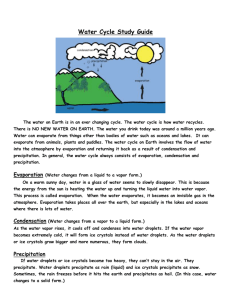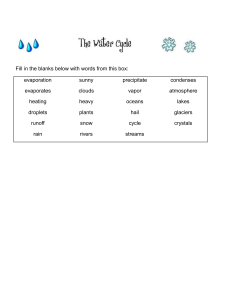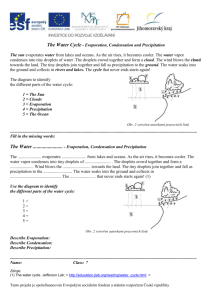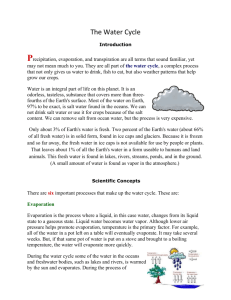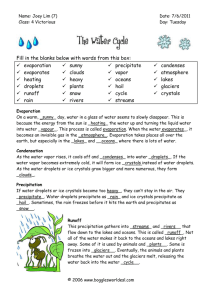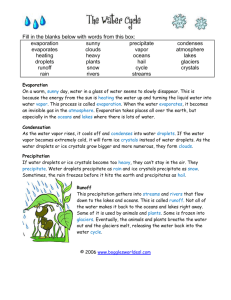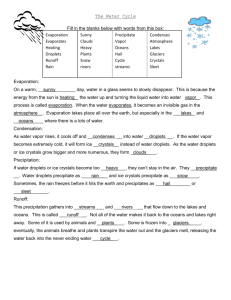I. Experimental setup - Engineering Information Institute
advertisement
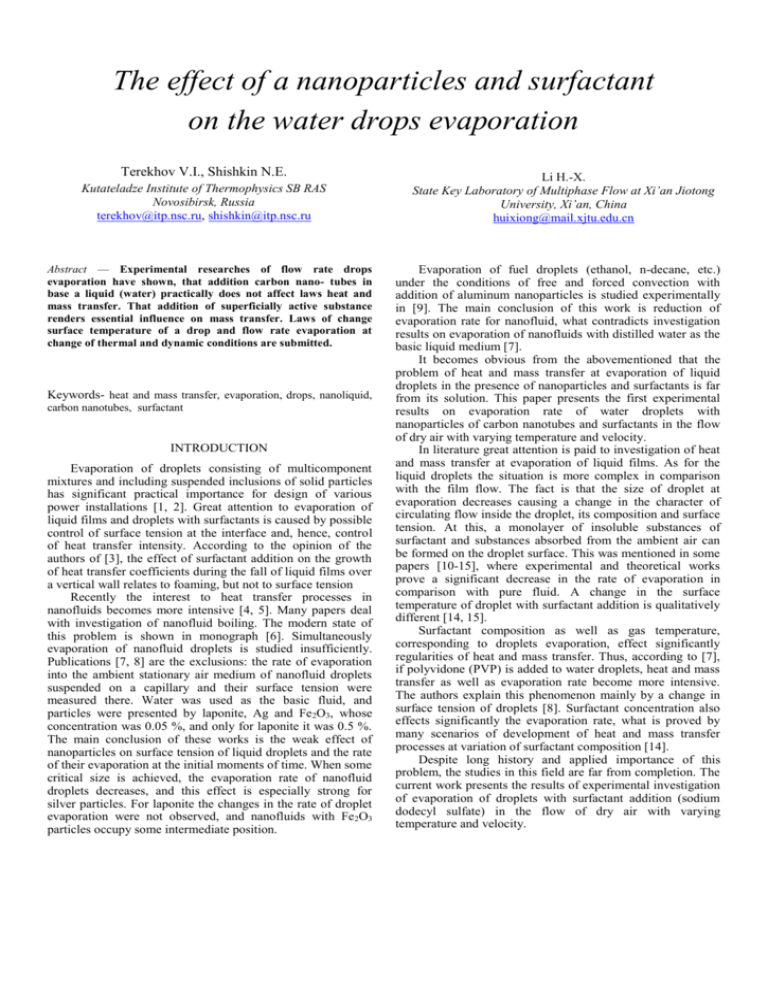
The effect of a nanoparticles and surfactant on the water drops evaporation Terekhov V.I., Shishkin N.E. Kutateladze Institute of Thermophysics SB RAS Novosibirsk, Russia terekhov@itp.nsc.ru, shishkin@itp.nsc.ru Abstract — Experimental researches of flow rate drops evaporation have shown, that addition carbon nano- tubes in base a liquid (water) practically does not affect laws heat and mass transfer. That addition of superficially active substance renders essential influence on mass transfer. Laws of change surface temperature of a drop and flow rate evaporation at change of thermal and dynamic conditions are submitted. Keywords- heat and mass transfer, evaporation, drops, nanoliquid, carbon nanotubes, surfactant INTRODUCTION Evaporation of droplets consisting of multicomponent mixtures and including suspended inclusions of solid particles has significant practical importance for design of various power installations [1, 2]. Great attention to evaporation of liquid films and droplets with surfactants is caused by possible control of surface tension at the interface and, hence, control of heat transfer intensity. According to the opinion of the authors of [3], the effect of surfactant addition on the growth of heat transfer coefficients during the fall of liquid films over a vertical wall relates to foaming, but not to surface tension Recently the interest to heat transfer processes in nanofluids becomes more intensive [4, 5]. Many papers deal with investigation of nanofluid boiling. The modern state of this problem is shown in monograph [6]. Simultaneously evaporation of nanofluid droplets is studied insufficiently. Publications [7, 8] are the exclusions: the rate of evaporation into the ambient stationary air medium of nanofluid droplets suspended on a capillary and their surface tension were measured there. Water was used as the basic fluid, and particles were presented by laponite, Ag and Fe2O3, whose concentration was 0.05 %, and only for laponite it was 0.5 %. The main conclusion of these works is the weak effect of nanoparticles on surface tension of liquid droplets and the rate of their evaporation at the initial moments of time. When some critical size is achieved, the evaporation rate of nanofluid droplets decreases, and this effect is especially strong for silver particles. For laponite the changes in the rate of droplet evaporation were not observed, and nanofluids with Fe2O3 particles occupy some intermediate position. Li H.-X. State Key Laboratory of Multiphase Flow at Xi’an Jiotong University, Xi’an, China huixiong@mail.xjtu.edu.cn Evaporation of fuel droplets (ethanol, n-decane, etc.) under the conditions of free and forced convection with addition of aluminum nanoparticles is studied experimentally in [9]. The main conclusion of this work is reduction of evaporation rate for nanofluid, what contradicts investigation results on evaporation of nanofluids with distilled water as the basic liquid medium [7]. It becomes obvious from the abovementioned that the problem of heat and mass transfer at evaporation of liquid droplets in the presence of nanoparticles and surfactants is far from its solution. This paper presents the first experimental results on evaporation rate of water droplets with nanoparticles of carbon nanotubes and surfactants in the flow of dry air with varying temperature and velocity. In literature great attention is paid to investigation of heat and mass transfer at evaporation of liquid films. As for the liquid droplets the situation is more complex in comparison with the film flow. The fact is that the size of droplet at evaporation decreases causing a change in the character of circulating flow inside the droplet, its composition and surface tension. At this, a monolayer of insoluble substances of surfactant and substances absorbed from the ambient air can be formed on the droplet surface. This was mentioned in some papers [10-15], where experimental and theoretical works prove a significant decrease in the rate of evaporation in comparison with pure fluid. A change in the surface temperature of droplet with surfactant addition is qualitatively different [14, 15]. Surfactant composition as well as gas temperature, corresponding to droplets evaporation, effect significantly regularities of heat and mass transfer. Thus, according to [7], if polyvidone (PVP) is added to water droplets, heat and mass transfer as well as evaporation rate become more intensive. The authors explain this phenomenon mainly by a change in surface tension of droplets [8]. Surfactant concentration also effects significantly the evaporation rate, what is proved by many scenarios of development of heat and mass transfer processes at variation of surfactant composition [14]. Despite long history and applied importance of this problem, the studies in this field are far from completion. The current work presents the results of experimental investigation of evaporation of droplets with surfactant addition (sodium dodecyl sulfate) in the flow of dry air with varying temperature and velocity. I. EXPERIMENTAL SETUP 0 T s, C 50 o t0 = 175 C 40 30 86 20 23 10 t, sec 0 0 25 TEMPERATURE OF DROPLET SURFACE 75 100 125 150 175 the character of temperature alteration in time is shown. For the droplets of pure water the average temperature and its minimal values became stable fast and almost coincided with the values at adiabatic evaporation of liquid [17], but in the presence of surfactant the surface temperature decreased initially, and when the minimal value was achieved, it increased by the factor of 1.5 – 2 in comparison with pure water (Fig.2). This tendency of temperature alteration in time at evaporation of droplets with surfactant was also observed in experiments [14]. It can be assumed that with a rise of particle concentration on the surface liquid evaporation becomes slower and as a sequence, the temperature increases. 13 12 11 Тmiddle 10 II. 50 Figure 1. Surface temperature of evaporating droplets: dark points – pure water, light points – nanofluid. 0 TS , C In experiments liquid droplets were suspended in the center of the air jet flowing from a channel of the 52-mm diameter. Air with low humidity (below 2 %) was supplied with the velocity of 0 ÷ 6 m/s, turbulence degree was ~ 5.5 %, and the jet temperature changed in the range of ~ 20 ÷ 200 0С. To compensate the gravity force and avoid droplet separation, the flow was directed vertically upwards. Droplets of distilled water with the diameter of ~ 2 ÷ 3 мм and droplets of nanofluid, where carbon nanotubes were used as the solid admixture, were the targets of research. Single-wall nanotubes were made by “Carbolex” company. They were of a random length, less than 1 m, and diameter of 1.3 nm. The initial mass content of carbon particles in a droplet was constant K0 ~ 0.1 %. In these experiments the droplets were located on a wire ring (wire diameter was 50 m). In the next experiments we added surfactant to distilled water. Sodium dodecyl sulfate, also called sodium lauryl sulfate, attributed to the class of anion surfactants, was used as the surfactant in these experiments [16]. Its chemical formula is С12Н25OSO3- Na+. This surfactant is a good penetrating and foaming agent. It is nontoxic, used in tooth pastes, food industry and cleaning solutions. We used the solution with mass concentration of surfactant of 0.15 %. In some experiments at sir jet heating mass concentration of surfactant was 0.07 %. Liquids by means of a syringe were fed to the tip of asbestos thread; the size of this thread did not exceed 25 m, what minimized significantly conductive heat supply to the studied object through the supporting thread. The temperature of droplet surface and their size were measured both for pure fluid and for fluid with carbon nanotubes or surfactants by thermographic camera Thermo Tracer TH7102MV at a change in the velocity and temperature of the streamlining air jet. The detailed description of experimental method and measurement errors is shown in [17, 18]. 9 Tmin 8 Measurement results on surface temperature of evaporating droplets are shown in Fig. 1 for different temperatures of the air flow. It can be seen that the surface temperature becomes stable fast and takes the equilibrium value with consideration of heat losses to the wire supporting this droplet [19, 20]. At this, the temperature of nanofluid almost coincides with the temperature of pure water in the studied range of ambient air temperatures, what proves the absence of nanoparticle addition influence on thermodynamic parameters of evaporation process. The temperature of droplets was not measured in [7], and this excludes the possibility of their even qualitative comparison with data of the current study. Simultaneously the presence of surfactant leads to significant changes in temperature of evaporating surface. This can be seen from Fig. 2, where the effect of surfactant on 7 t , sec 6 0 30 60 90 120 150 180 Figure 2. Surface temperature of evaporating droplets: dark points – pure water, light points – water and 0.15 % of surfactant; Тс = 19.8 0С, U0 = 3.2 m/s. III. INTENSITY OF DROPLET EVAPORATION Experimental data on the rate of liquid droplet evaporation were generalized using the method presented in [17]. From the equation of heat balance on the surface of evaporating droplet T Ж T0 TЖ jW L r 7 d 3/2 at adiabatic evaporation j w L = α∙(T0 – Tl) 6 and from the use of relationship for its heat transfer coefficient [21] Nu = 2 + 0,53∙Re 0.5∙Pr1/3 where Fo = t ∙ao / d02 is Fourier number, Ku = r / [cpo ∙(To - Ts)] is Kutateladze criterion of phase transformation, r and cpo are latent heat of vaporization and heat capacity of gas, and Ts and T0 are the temperature of vapor-gas mixture on the droplet surface (saturation line) and in the ambient air flow, respectively. In contrast to the known square law of evaporation (d2 law) [22], valid for the low values of Reynolds number (Re0→ 0 and Nu = 2); at high values of Re as it follows from (2), law (d / d0)2 works. In this manner a change in droplet diameter at evaporation was considered. The change in size of pure water droplets and droplets with 0.15 % of nanotubes is shown in Fig. 3 for the jet temperature of 23 0С; in Fig. 4 the jet temperature is 175 0С. According to both figures, the addition of solid admixture did not effect evaporation intensity (the angle of inclination, characterizing evaporation rate, was kept almost in all experiments). t, sec 3 0 10 20 30 40 50 60 Figure 4. Evaporation regularity for water and nanofluid droplets at То = 1750С, U0 = 4 m/s. Generalization of experimental data shows that results of experiments with water and nanofluid droplets are described by linear empirical dependence (d / d 0)3/2 = 1 – 0.676∙K. (3) These data are shown in Fig. 5. It is obvious that in this form all experimental data have a tendency to generalization. At this, calculation by formula (3) almost coincides with calculation of evaporation of water droplets at their convective streamlining [17], with consideration of additional heat supply through thermocouple wires supporting the droplet [19 - 20]. 1.5 (2) Nanofluid 4 (d/do) Re 0 Fo , Ku 0.. 5 (d / d 0)3/2 = 1 – A∙ 5 (1) with prevalence of convective transfer (Re >> 1, in experiments the Reynolds number was varied within Re0 = 500 ÷ 2000) we can derive the following dependence for the droplet diameter Water 1.0 0.9 1 - 0.676 K 0.8 0.7 0.6 8 0.5 23 80 0 175 С 3/2 9 d Water droplets nanofluid 0.4 7 0.0 Nanofluid 0.2 0.4 0.6 K = Re 0.5 0.8 Fo / Ku 6 Figure 5. Generalization of experimental data on evaporation of water and nanofluid droplets 5 4 t, sec Water 0 50 100 150 200 Figure 3. A change in size of water and nanofluid droplets at air temperature То = 23 0С, U0 = 4 m/s. If a surfactant is added, the rate of droplet evaporation decreases. This can be seen from Fig. 6, where measurements of droplet diameter alteration in time are shown. The angle of experimental data inclination is significantly lower in the presence of surfactant as compared to pure fluid, what proves the suppression of evaporation processes. REFERENCES d 1.5 3,5 2,5 2,0 water 1,5 1,0 t , sec -20 0 20 40 60 80 100 120 140 160 180 200 220 Figure 6 Evaporation intensity for water droplets and water droplets with surfactant additions at air temperatures of 19 and ~ 80 0C, the flow velocity is 4.3 m/s. Experimental data on evaporation of water droplets with surfactant shown by expression (2) are presented in Fig. 7. In this form experimental results are generalized and described satisfactorily by linear correlation dependence (d / d 0)3/2 = 1 – 0.552∙K. (4) 1,0 ( d / d0 ) 1.5 S.S. Sazhin, “Advanced models of fuel droplet heating and evaporation,” Progress in Energy and Combustion Sciense, vol. 32, 2006, pp. 162214. [2] P.L.C. Lage., R.H. Rangel., C.M. Hackenberg,. “Multicomponent heat and mass transfer for flow over a droplet,” Int. J. Heat and Mass Transfer, vol. 34, 1993, pp. 3573-3581. [3] B.H. Shan, R. Darby, “The effect of evaporative heat transfer in vertical film flow,” Int. J. Heat and Mass Transfer, vol. 16, 1973, pp. 1889 – 1903. [4] S.U.S. Choi, “Nanofluids: A new field of scientific research and innovative applications, ”Heat Transfer Eng., vol. 29, 2008, pp. 429 441. [5] V.I. Terekhov, S.V. Kalinina, V.V. Lemanov, “The mechanism of heat transfer in nanofluids: state of the art (review). Part 2. Convective heat transfer”. Thermophysics and Aeromechanics, vol. 17, 2010, pp. 157171. [6] S.K. Das, S.U.S. Choi, W. Yu, T. Pradeep, ”Nanofluids. Science and Technology.” Jone Wiley & Sons Inc., Publication. 2008. -572 P. [7] R.-H. Chen, T. X. Phuoc, D. Martello, “Effect of nanoparticles on nanofluid droplet evaporation,” Int. J. Heat and Mass Transfer, vol. 53, 2010, pp. 3677 - 3682. [8] R.-H. Chen, T. X. Phuoc, D. Martello, “Surface tension of evaporating nanofluid droplets,” Int. J. Heat and Mass Transfer, vol.54, 2011, pp. 2459 - 2466. [9] Y. Gan, L. Qiao, “Evaporation characteristics of fuel droplets with the addition of nanoparticles unde natural and forced convection,” Int. J. Heat and Mass Transfer, vol. 54, 2011, pp. 4913-4922. [10] R.S. Bradley, “The rate of evaporation of micro-drops in the presence of insoluble monolayers,” J. Colloid. Sci., vol. 10, 1955, pp. 571-575. [11] B.V. Deryagin, Yu.S. Yu.S. Kurgin, S.P. Bakanov, "About effects of monolayers on a drop evaporation,” Doklady Akademii Nauk, 1960, Vol. 135, pp. 1417- 1420 (in Russian). [12] V.A. Borzilov, N.V. Klepikova, V. M. Merkulovich “Effect of a surfactants on growth and evaporation drops,” Meteorology and Gidrology, 1979, № 5, pp. 41 – 48 (in Russian). [13] B.V. Deryagin, Yu.S. Kurgin, “Unsteady drop evaporation with adsorbed layer,” Doklady Akademii Nauk, 1964, Vol. 155. pp. 644 – 646 (in Russian). [14] P.A. Sadd, J.A. Lamb, R.Clift, “The effect of surfactants on heat and mass transfer to water drops in air,” Chemical Engineering Science, vol. 47, No 17/18, 1992, pp. 4415-4424. [15] A.M. Hashem, “Effect of surfactants on mass transfer coefficients of single liquid drops,” Alexandria Engineering Journal, vol. 44, 2005, pp. 477 – 486. [16] Surfactants and washing-up liquids // Handbook. Ed. Abramzon A.A.Moscow. 1993 (in Russian). [17] V.I. Terekhov, V.V. Terekhov, N.E. Shishkin, K.Ch. Bi, “Heat and mass transfer in disperse and porous media experimental and numerical investigations of nonstationary evaporation of liquid droplets”, J. Eng. Physics and Thermophysics, vol. 83, 2010, pp. 883-890. [18] V.I. Terekhov, N.E. Shishkin, “Adiabatic evaporation of binary liquid mixtures on the poous ball surface,” Thermophysics and Aeromechanics. 2009, Vol. 16, pp. 239-245. [19] N.A. Fuhcs, Evaporation and droplet growth in gaseous media. The Pergamon Press, Oxford. 1959. 72 pp. [20] T. Harada, H. Watanabe, Y. Suzuki, H. Kamata, Y. Matsuhita, H. Aoki, T. Miura, “A numerical investigation of evaporation characteristics of fuel droplets suspensed from a thermocouple,” Int. J. Heat and Mass Transfer, vol. 54, 2011, pp. 649 - 655. [21] W.E. Ranz and W.R. Marshall, “Evaporation from drops,” Chem. Eng. Prog., vol. 48, 1952,pp. 141-146 and 173 - 180. [22] D.B. Spalding, Some fundamentals of combustion. London, Butterworth’s. - 1955. [1] 3,0 0,9 0,8 0,7 0,6 1 - 0.552 К 0,5 0,4 К 0,3 0,0 0,2 0,4 0,6 0,8 1,0 Figure 7. Generalization of experimental data on evaporation of droplets with surfactant. If we compared data in Fig.7 with results obtained for pure water (Fig.5) or linear relationship (3) with (4), we can made the important conclusion that surfactant addition leads to a significant decrease in the rate of evaporation. A decrease in inclination angle of linear approximation is ~ 35%, what finally gives the same difference between the values of transverse matter flux on the surface of evaporating droplet as well as between the coefficients of heat and mass transfer. Results of the current study coincide qualitatively with data of [14,15], where a decrease in evaporation rate of droplets with surfactant additions in the stationary gas medium was also determined. The work was financially supported by the Russian Foundation for Basic Research (project-11-08-91156-GFEN).
